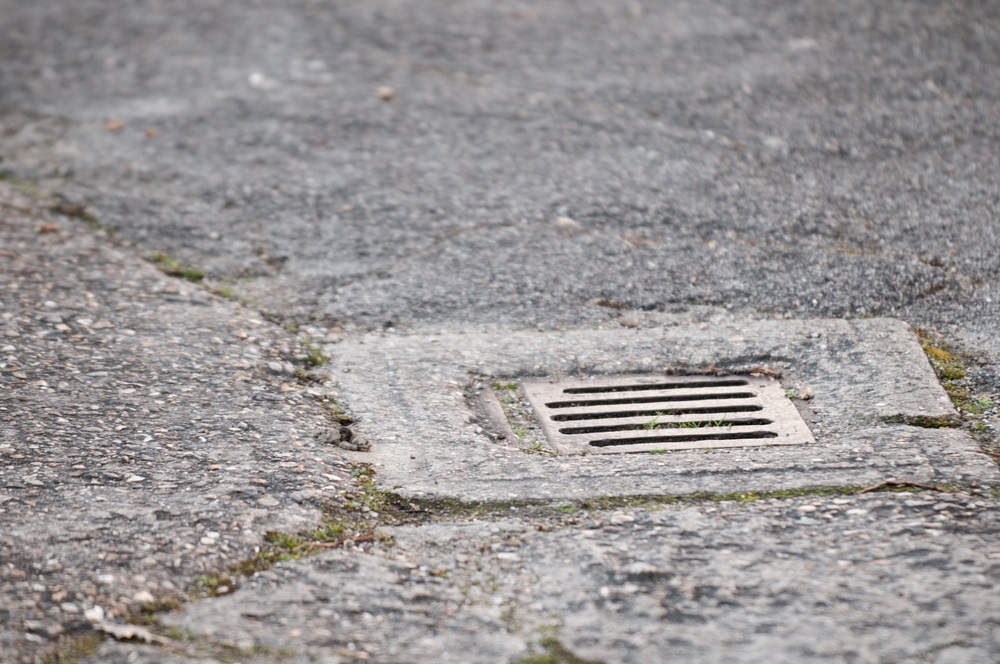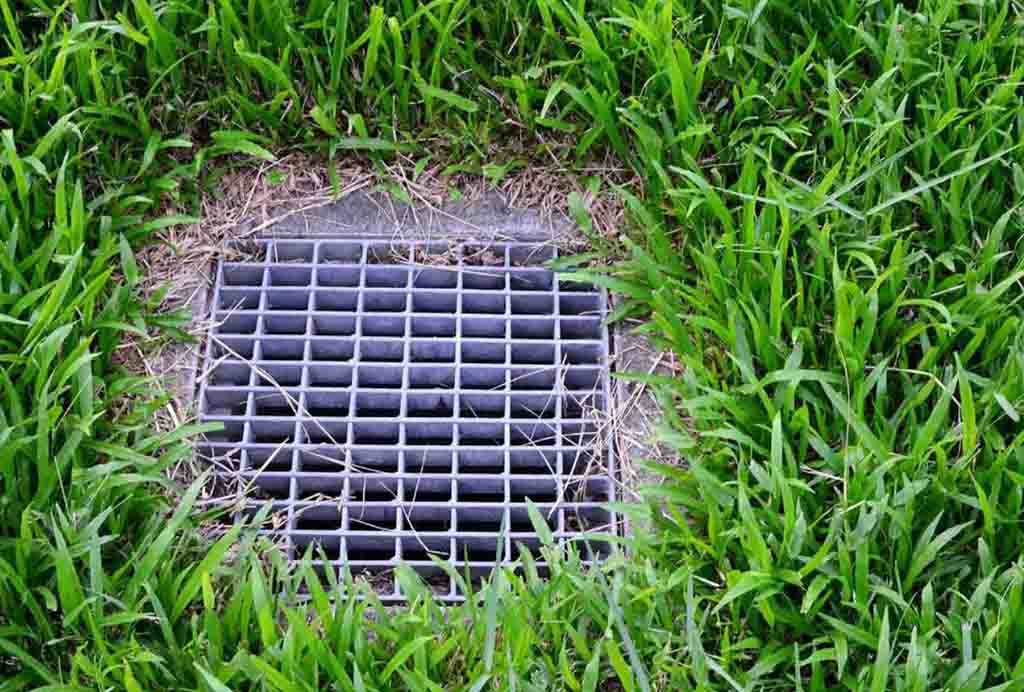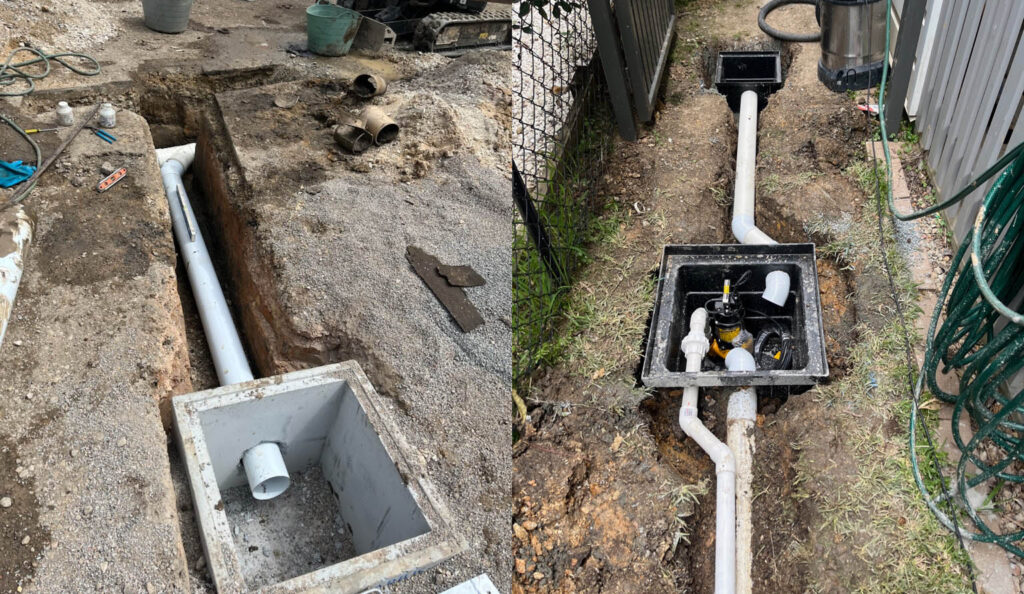Outdoor drains become blocked by leaves, mud, soil, and other debris that build up over time and restrict water flow. To unblock an outside drain, start by removing any visible surface debris, then flush the drain with water to check if it clears. If the blockage persists, you may need to use drain rods or a high-pressure hose to break up and remove deeper clogs.
You might think you know how to unblock an outside drain simply because you’re confident using a plunger on a toilet or kitchen sink. However, outside drain blockages can be very different and can be much more challenging to clear.
Why exactly is knowing how to unblock a drain pipe outside different from unblocking your sink drain inside your home?
Firstly, the outside drain blockage is more complex and difficult because of the physical drain size difference. But it’s also because outside drains are susceptible not only to all of the things that cause internal drain blockages, but also leaves, mud, and other external specific factors.
If you have flooding or water pooling in your yard right now, don’t delay calling for help with blocked stormwater drains – a major rain could be a disaster. But if your outside drain is blocked and you’re keen to try your hand as an amateur outside drain unblocker, read on.
Schedule Seasonal Drain Inspections
Before anything else, think about whether you’ve neglected your outside drain. Consistent maintenance is the best way to prevent blockages.
- Is your outside drain covered with a cover or grate? The whole idea is to prevent debris like leaves and mud from getting in there.
- How often do you clean out your drains? Do it every couple of months or so, whether it’s blocked at all or not. It’s as simple as blasting your garden hose down there and hacking away at any potential blockage with a drain rod.
- Another awesome preventative measure is a biological enzyme cleaner product, which you should pour into the drain now and then when there are no rain clouds in the sky. It works by using natural bacteria to eat away at the organic debris before it becomes a major problem.
Now that we’ve stressed the value of prevention, let’s focus on how to unblock an outside drain.
Unblock Drains Outside: DIY Methods
1. Use your hands
To unblock an outside drain using your hands, put on rubber gloves first. Wear safety goggles and a mask to avoid contact with contaminated water.
Carefully lift or unscrew the drain cover. Set it aside in a clean area to avoid further contamination.
Look inside the drain to identify any visible blockages such as leaves, mud, or accumulated debris.
Reach into the drain and pull out as much debris as possible by hand. Place the removed material into a bucket or garbage bag for proper disposal.
Once you have cleared the visible blockage, pour water into the drain to see if it flows freely. This helps confirm whether the obstruction has been fully cleared.
Rinse the drain cover thoroughly before placing it back. Secure it properly to prevent future debris from entering.
2. Use a drain rod
Connect the rod sections securely. Add as many pieces as needed to reach the estimated depth of the blockage. Make sure each connection is tight to avoid losing a section in the drain.
Carefully push the rod into the drain opening and guide it toward the blockage.
When you feel resistance, begin rotating the rod clockwise while gently pushing forward. Avoid turning it counterclockwise, as this can cause the rod to unscrew and separate inside the drain.
Flush the drain with water to confirm it is fully cleared. Wash the drain rod thoroughly and dry it before storing.
3. Use a hose
Select a garden hose with an adjustable nozzle or use a pressure attachment if available. Higher water pressure is more effective at dislodging debris.
Turn on the water at full pressure to flush out the blockage. The force of the water helps break up and move debris further down the drain.
For stubborn blockages, use the hose in combination with a drain rod. Alternate between using the rod to break up the blockage and the hose to flush it through.
Watch the water level to see if it drains away freely. If it does, this indicates that the blockage has been cleared.
Rinse the surrounding area and clean your equipment thoroughly before storing it.
4. Try water and bleach
If you’re still struggling with a stubborn outside drain blockage, it may be time to use a stronger chemical approach.
Fill a bucket with hot water, add a couple of cups of bleach, and carefully pour the mixture down the drain. Wear protective gloves and goggles to avoid contact with splashes, as bleach can irritate your skin and eyes.
After pouring in the mixture, allow it to sit for at least 10 to 15 minutes to give it time to act. For better results, follow up by using a drain rod to physically break up any loosened debris.
Bleach works as a strong oxidizing agent. It helps dissolve organic matter, while also eliminating odours. However, bleach is not effective for solid clogs like large clumps of leaves or heavy mud.
How Do Plumbers in Gold Coast Unblock Outside Drains?
If DIY methods haven’t worked, or you’re dealing with repeat blockages, bad smells, or overflow, it’s time to call in the experts. Here’s how a licensed plumber tackles a blocked outside drain:
- Inspection with CCTV Drain Camera: The first step is often a drain camera inspection. This gives a clear view of what’s causing the blockage, whether it’s tree roots, collapsed pipes, grease build-up, or foreign objects.
- High-Pressure Water Jetting: One of the most effective tools professionals use is a high-pressure water jet. It blasts away built-up debris, grease, and even roots without damaging the pipes.
- Root Cutting Equipment: If tree roots are the culprit, plumbers can use mechanical root cutting tools to remove them safely and clear the line.
- Pipe Repairs or Relining: If the pipe is damaged or collapsed, a more permanent solution like pipe relining or partial replacement may be needed to restore proper flow.
- Ongoing Prevention: Professionals may also recommend preventative measures, such as root barriers, regular jetting, or installing a drain guard to stop debris from entering the pipe again.
Solve Blocked Drain Issues with Drain Masters Plumbers
While DIY methods can fix some plumbing issues, contacting an experienced plumber can prevent costly mistakes and further damage.
Professional plumbers understand subtle details and techniques that most homeowners might overlook. Our drain masters in Gold Coast and Tweed Heads will keep your drain safe and effective.
At Drain Masters Plumbing, our team of Gold Coast plumbing and drainage experts has the right equipment and expertise to fix outdoor drain blockages quickly and properly. We provide efficient blocked drain cleaning in Gold Coast, Tweed Heads, and beyond. For a fast fix with a great low price, get in touch with our friendly local drain plumbing team today.
Frequently Asked Questions
Does home insurance in Australia cover blocked outside drains?
Most standard home insurance policies in Australia do not cover the cost of clearing a blocked drain if the blockage is due to gradual buildup or poor maintenance. Some insurance may cover resulting damage to your property (such as water damage) if the blockage causes unexpected flooding.
How often should I clean or maintain my outside drain?
Maintain outside drains at least every few months, especially before and after heavy rain seasons. Regular maintenance keeps the water flowing away from your property.
Can tree roots cause blockages in outside drains?
Yes. Tree roots can enter small cracks in pipes in search of water and grow inside. They create significant blockages and even damage the pipes.
You can use a chemical tree root killer specifically for plumbing systems. These products contain ingredients that kill the roots inside the pipes without harming the entire tree or surrounding vegetation.






